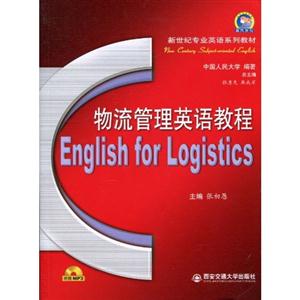物流管理英语教程-(附赠MP3光盘一张)

|
物流管理英语教程-(附赠MP3光盘一张)作者:中国人民大学 开 本:16开 书号ISBN:9787560535098 定价:32.5 出版时间:2010-06-01 出版社:西安交通大学出版社 |
物流管理英语教程-(附赠MP3光盘一张) 本书特色
《物流管理英语教程》是新世纪专业英语系列教材之一。
物流管理英语教程-(附赠MP3光盘一张) 目录
Unit 1 What Is Logistics?Additional Reading: Successful Logicsics Systems of Five Well-know FirmsUnit 2Design a Logistics StrategyAdditional Reading: Logistics StrategyUnit 3Supply Chain IntegrationAdditional Reading: Obstacles to Process Intergration along the Supply ChainUnit 4 Supplier Selection and EvaluationAdditional Reading: Single Versus Multiple SourcesUnit 5Logistics Location StructureAdditional Reading: Facility Location DecisionsUnit 6 Just-in.timeAdditional Reading: Process ManagementUnit 7 Adjusting CapacityAdditional Reading: Capacity PlanningUnit 8 Bar Coding and ScanningAdditional Reading: Critical Location FactorsUnit 9 Cross-dockingAdditional Reading: Managing Distribution ChannelsUnit 10 Electronic Communication in Supply ChainsAdditional Reading: Electronic Data Interchange (EDI) and PurchasingUnit 11 Service Parts Logistics & Service Logistics ManagementAdditional Reading: The Primary Concerns of Servise Response LogisticsUnit 12Lean Supply ChainAdditional Reading: Third-Party LogisticsUnit 13 Internatinal CargoAdditional Reading: Ocean CargoAppendix Ⅰ Reference Translation of the Main TextsAppendix Ⅱ Key to the ExercisesAppendix Ⅲ TapescriptsAppendix Ⅳ Glory物流管理英语教程-(附赠MP3光盘一张) 节选
《物流管理英语教程》中百分之八十的内容选自*新出版的英文原版著作。在准确界定物流管理的基础上,对物流管理的方方面面做了有侧重的描述介绍。其中涉及人员场地的选择、物流流程的设计、准时制、条形码扫描、库存管理、电子信息沟通、精细供应链,以及国际货运管理。有理论,有实例;有成功,有教训。每单元有正课文一篇,副课文一篇,以利于学生既能严谨细致地学习,又能有充足的材料浏览,拓宽视野。
物流管理英语教程-(附赠MP3光盘一张) 相关资料
插图:Many of the logistical techniques learned during World War II were temporarilyignored during the postwar surge in economic activity. Marketing managers turned their attention to filling the postwar demand for goods. It was not until therecessions of the 1950s that managers started to examine their physical distributionnetworks. In 1958, the recession and profit squeeze created an environment inwhich business began searching for more effective cost-controls systems. Almostsimultaneously, many firms realized that physical distribution and logistics were activities whose cost had neither been carefully studied nor coordinated. A number of other trends were becoming apparent, and they made it necessary to focus attention on product distribution. Eight trends can be identified.First, transportation costs rose rapidly. Traditional methods of distribution hadbe come more expensive, and management became aware of the need to controlthese costs better. In the 1970s, these factors became more critical, with fuelprices soaring and spot shortages of fuel occurring. Transportation could no longerbe considered as a stable factor in the business planner's equations. Higher-levelmanagement had to become involved in transportation-related aspects of logistics atboth the operating and policy levels because of the many new decisions that had tobe made to adapt to the rapid changes in all areas of transport. Staring in the late1970s, deregulation of common-carrier transportation changed many of the long-established "rules of the game" that had governed shippers' use of transportation. Many new operating-and policy-level decisions had to be made by the users oftran sport in order to take advantage of the new laws.Second, production efficiency was reaching a peak. It was becoming very difficult to generate significant additional cost savings because the "fat" had been taken out of production. Physical distribution and logistics, however, were relatively untouched from an efficiency perspective.Third, there was a fundamental change in inventory philosophy. At one time, retailers held approximately half of the finished product inventory, and wholesalers and manufacturers held the other half. Beginning in the 1950s, more sophisticated inventory-control techniques, especially in the grocery business, reduced total amounts of inventory and changed the proportions to only 10 percent held by retailers and 90 percent by distributors and manufacturers.
外语 大学英语 大学专业英语教材
在线阅读
- 最新内容
- 相关内容
- 网友推荐
- 图文推荐
| [高考] 2022 西安电子科技大学《软件工程》大作业答案 (2022-04-25) |
| [家长教育] 孩子为什么会和父母感情疏离? (2019-07-14) |
| [教师分享] 给远方姐姐的一封信 (2018-11-07) |
| [教师分享] 伸缩门 (2018-11-07) |
| [教师分享] 回家乡 (2018-11-07) |
| [教师分享] 是风味也是人间 (2018-11-07) |
| [教师分享] 一句格言的启示 (2018-11-07) |
| [教师分享] 无规矩不成方圆 (2018-11-07) |
| [教师分享] 第十届全国教育名家论坛有感(二) (2018-11-07) |
| [教师分享] 贪玩的小狗 (2018-11-07) |






